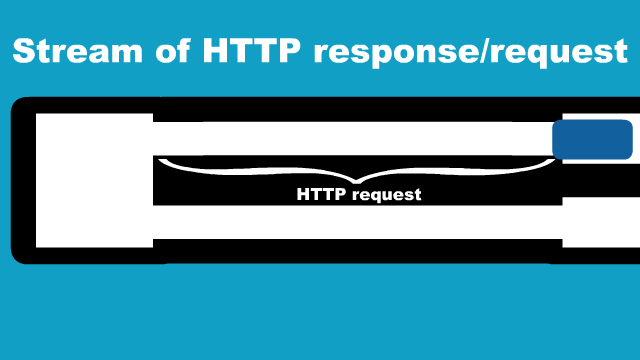Akka HTTP streaming at the HTTP layer

The previous article Akka HTTP and TCP streaming introduced how Akka HTTP processes data in a streaming fashion at the TCP layer. Now I am going to explain the streaming behavior at the HTTP request/response level.
The above animation illustrates streaming in Akka HTTP at the HTTP layer. Each HTTP request is converted to an HTTP response in the end, and this conversion logic is called the handler here, which is passed to the bindAndHandle method to start up the HTTP server.
import akka.http.scaladsl.Http
Http().bindAndHandle(handler, "localhost", 8080)The handler has the type of Flow[HttpRequest, HttpResponse, Any] as you can see from the signature of the bindAndHandle method.
def bindAndHandle(
handler: Flow[HttpRequest, HttpResponse, Any],
interface: String, port: Int = DefaultPortForProtocol,
connectionContext: ConnectionContext = defaultServerHttpContext,
settings: ServerSettings = ServerSettings(system),
log: LoggingAdapter = system.log)(
implicit fm: Materializer
): Future[ServerBinding] = ...So the handler in Akka HTTP convertes HttpRequest into HttpResponse and that's where you application-level logic resides.
High-level and Low-level APIs
The handler in type of Flow[HttpRequest, HttpResponse, Any], can be implemented in two ways in Akka HTTP.
In this article, I'm going to introduce them very briefly, and discuss them in much more detail in separate articles.
The first way is to use the high-level API with Routing DSL. Interestingly, the handler written in Routing DSL has the type of Route not Flow, but there is type-class based implicit resolution going on, to convert the Route to Flow[HttpRequest, HttpResponse, Any] behind the scene.
val route: Route = path("..." ) {
get {
complete(...)
}
}
// route: Route is resolved to Flow[HttpRequest, HttpResponse, Any]
// by type-class based implicits
Http().bindAndHandle(route /*route as handler*/, "localhost", 8080)Writing the handler in Routing DSL in most cases is much easier than writing Flow[HttpRequest, HttpResponse, Any] directly. So most of the cases you would go with the high level API.
However, as the philosophy of Akka HTTP says, in case it is more suitable to directly implement the HttpRequest to HttpResponse conversoin logic rather than Route, Akka HTTP also offers the low-level API, and we can directly implement the handler in HttpRequest => HttpResponse as follows.
val handler: HttpRequest => HttpResponse = {
case HttpRequest(GET, Uri.Path("/"), _, _, _) =>
HttpResponse(...)
}
Http().bindAndHandleSync(handler, "localhost", 8080)HttpRequest => HttpResponse can be passed to bindAndHandleSync which is internally converted to Flow[HttpRequest, HttpResponse, Any]. Note that we used bindAndhHandleSync which is different from bindAndHandle wa saw earlier.
def bindAndHandleAsync(...) = {
...
...
bindAndHandle(
Flow[HttpRequest].mapAsync(parallelism)(handler),
interface,
port,
connectionContext,
settings,
log)
}HTTP Pipelining
HTTP pipelining means processing the next HTTP request before sending the HTTP response for the current HTTP request.

Compare it with the animation we saw earlier, without pipelining.

Although it is generally discouraged, also disabled by most browsers, HTTP pipelining is still supported in Akka HTTP. It can be achieved by either:
- Changing
akka.http.server.pipelining-limitconfig value, or - Passing the
parallelismparameter to thebindAndHandleAsyncmethod under theHttpobject (default = 1, i.e. pipelining disabled)
def bindAndHandleAsync(
handler: HttpRequest ⇒ Future[HttpResponse],
interface: String, port: Int = DefaultPortForProtocol,
connectionContext: ConnectionContext = defaultServerHttpContext,
settings: ServerSettings = ServerSettings(system),
parallelism: Int = 1,
log: LoggingAdapter = system.log)(implicit fm: Materializer
): Future[ServerBinding]Again, HTTP pipelining is a discouraged practice, so if you need to enable this feature, be warned about unwanted consequences.